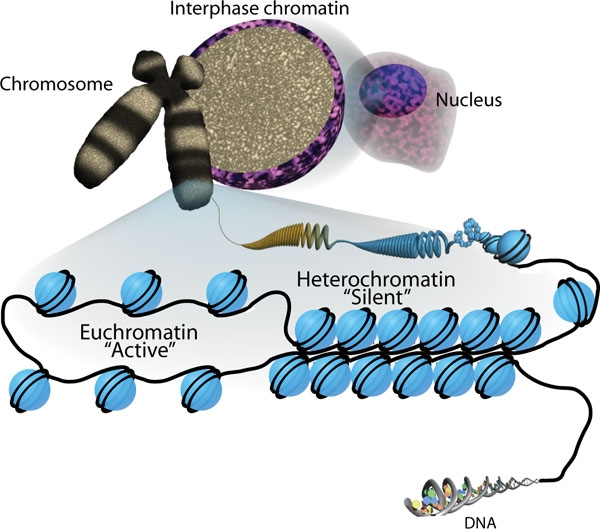Playlist
Show Playlist
Hide Playlist
Review: Cell and Molecular Biology Course
-
Slides 02 Cell and Molecular Biology IntroductionToMedicalGenetics.pdf
-
Download Lecture Overview
00:00 So, before we dig into the content of this course, I wanted to take just a moment to recap some of the information that we covered in the cell and molecular biology course that’s relevant to molecular genetics because there are lots and lots of material that’s not necessarily medical genetics but is the content of cell and molecular biology. 00:23 I didn’t really want to repeat them here. So first of all, we have to understand that DNA is this double helix and it’s packed tightly. It’s wrapped around nucleosomes. Those nucleosomes are like pearls on a necklace. 00:39 They stack into a little tube. That tube is this piece that we see here. Then that will coil. So this string of beads that are packed together then coils and then we see that it super coils. Then beyond the super coiling, we see that that all gets compacted and coils around some more and finally we have the chromosomes. 01:01 So, that’s something we’ve covered before in the specifics of how it’s all held together. We also have covered gene structure and function. You’ll recall that not only is there the gene and coding piece of the DNA. 01:14 But there’s a 5-prime end and a 3-prime untranslated end as well as this whole TATA box up at the beginning, where we have the promoter region and many different proteins attaching on there in order to regulate gene expression. Then we also looked at how gene expression happened in lots and lots of details. 01:35 We have the DNA and that DNA template is transcribed into messenger RNA and then messenger RNA is translated into the eventual product which are proteins. Of course remember, all those regulatory proteins that attach to the TATA box in the promoter region are also transcribed from DNA into messenger RNA and become proteins themselves. 02:00 So, we have multilayers of transcription and translation going on and thus, multilayers of control of gene expression and thus, multilayers of different things that could go array with genes that are either phenotypic like hair color or sickle cell or not so phenotypic as in regulatory proteins. So, we also covered a lot of techniques in biotechnology. 02:29 Some of them are pictured here where we looked at how we get genes out of, let’s say, human cell. We’re taking the human insulin gene maybe. We’re trying to put it into a bacterial vector. So, we use things like EcoRI restriction enzymes to create sticky ends. Then we can stick that foreign DNA or the host, I mean the hormone DNA, the insulin DNA into the bacterial vector chromosome. Then that bacterial vector can be made into libraries and so on and so forth. So, some of these images should look pretty familiar to you at this point. 03:11 The technologies that we covered specifically were recombinant DNA that is using restriction enzymes to stick different pieces of DNA together. We looked at the probing for DNA, so using probes to identify and visualize DNA and then sticking pieces of DNA that have been visualized in DNA cloning. That is the piece where we put the insulin gene into the bacterial vector in order for the bacteria to then transcribe and translate and make human insulin. Then we can further that and put specific pieces by chopping up DNA of an entire organism into sections and having them in vectors. So there’s our DNA libraries as well as gel electrophoresis in which we can separate larger and smaller pieces of DNA. That technique can be used in part to do DNA fingerprinting. 04:07 We also covered FISH. We’ll see FISH again in this course but that’s fluorescence in situ hybridization as well as Sanger sequencing, Sanger dideoxy sequencing, how we used to do it with vials and test tubes. Now, we do it in an automated fashion. Now, we can actually sequence the whole genome. We have artificial chromosomes. 04:33 So, creating our own chromosomes rather than using a bacteria or a viral vector in order to insert the interesting piece of DNA like this hormone insulin. We also looked at specific restriction endonucleases called the Cas9 and CRISPR system which can specifically target where to insert DNA. This is probably the launching path, I think for how we’re going to be able to target DNA specifically into certain locations in certain cells. Anyway, whole genome sequencing is one of the things that has really allowed us to move forward in the field of medical genetics because again, we’ve been able to springboard from that into genomics and such.
About the Lecture
The lecture Review: Cell and Molecular Biology Course by Georgina Cornwall, PhD is from the course Introduction to Medical Genetics.
Included Quiz Questions
Which of the following determines where transcription starts?
- Promoter
- Enhancer
- Insulator
- Transcription factor
- Silencer
Which enzyme is used in DNA recombinant technology?
- Restriction endonuclease
- Exonuclease VIII
- RNA polymerase II
- Helicase
- DNA topoisomerase
Which technique is used to separate DNA fragments according to their size?
- Gel electrophoresis
- Fluorescence in situ hybridization (FISH)
- Whole-genome sequencing
- DNA cloning
- CRISPR-Cas9
Customer reviews
5,0 of 5 stars
| 5 Stars |
|
1 |
| 4 Stars |
|
0 |
| 3 Stars |
|
0 |
| 2 Stars |
|
0 |
| 1 Star |
|
0 |
You do a wonderful job of clearly and concisely breaking down concepts.




